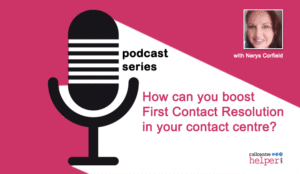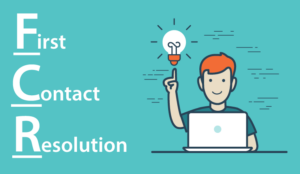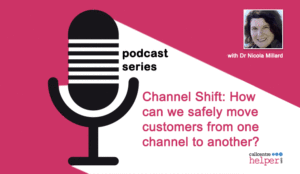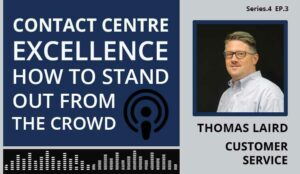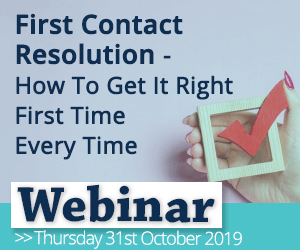
The Contact Centre Podcast: Episode Three
In this episode, Nerys Corfield of Injection Consulting shares her own observations of how contact centres are using First Contact Resolution (FCR) and talks about the metric’s growing popularity.
As part of our discussion, we also consider the foundations for measuring FCR realistically, how to use your FCR figure to make positive changes and ask if “One and Done” is right for every scenario?
To the podcast directly from this webpage, just hit the play button below:
The Contact Centre Podcast – Episode 3:
How Can You Boost First Contact Resolution In Your Contact Centre?
This podcast was made possible by our sponsor, Genesys. We now have a new link to visit their website, instead of the link mentioned in the podcast to request a demo.
So, to find out more about Genesys, simply visit their website
Podcast Time Stamps
- 3:42 – The Importance of FCR
- 5:55 – Making the FCR Concept a Reality
- 9:55 – Measuring FCR
- 13:12 – Assessing Failure Demand With FCR
- 16:14 – How FCR Impacts Service Level
- 19:18 – Getting Started With FCR
- 23:59 – FCR Pitfalls to Avoid
- 28:04 – Setting FCR as an Agent Target
Here is a Transcript to the Podcast
Jonty Pearce: All right. Hello everyone. In today’s webinar we’re going to be looking at First Contact Resolution and we’re delighted to welcome Nerys Corfield from Injection Consulting. Welcome to this podcast, Nerys.
Nerys Corfield: Thanks, Jonty. Lovely to be here.
Jonty: And you’ve been working with contact centres up and down the country for quite a while now.
Nerys: Yes. Yeah, I work up and down the country, that’s fair to say. I’m in and out of contact centres a couple of times a week doing audits.
Jonty: So you do a speed audit of a contact centre: how well it’s performing, how well the people are going, what the processes are, what the technology is?
Nerys: Exactly that. Yeah. So I use a framework called the seven P’s framework, and I look at lots of different things, spend lots of time with the guys on the calling floors, watching how they’re interfacing with their technology solutions. I am really the middleware between operations and tech but I look at the whole piece and I do it in a very quick timeframe.
Jonty: And one of the things you look at is presumably metrics.
Nerys: Yes. Yeah. That forms part of the performance bit of my seven P’s. Yes. So I look to understand what metrics that the centre’s being driven against and the advisors are being driven against and understand how those measurements are being pulled together as well.
Jonty: So we do quite a number of surveys on metrics. I think 10 years ago when we did those surveys, Average Handling Time came out as the top. And increasing now we’re seeing things such as Quality Scores and increasingly First Contact Resolution as a metric coming out.
Nerys: Yeah, definitely. There’s not many centres that I go to that don’t have First Contact Resolution as part of their monthly or daily or weekly MI Stack.
Jonty: So why do you think that First Contact Resolution has become so important?
Nerys: Well, it’s interesting because I think it’s a little bit like service levels insomuch as everybody knows that they should be doing it and they think they should be doing it 80/20. So there’s a bit of group-think mentality going in to it, because actually when I use root cause analysis to understand why it’s important to that centre to be using First Contact Resolution, I get some conflicting information from the different stakeholders that I’m asking, and the contact centre manager will say, “It’s on this because of this.” And then the advisors’ understanding of why they’re measuring it or why they’re being asked to really consider it is completely different.
There’s three areas that it identifies. It doesn’t identify that the advisors aren’t doing a very good job. In most cases it can be an indicator of they haven’t got the right knowledge or they haven’t had the right training, they haven’t got the right coaching, so it’s a flag for that. I don’t think it’s the best flag for that, but that’s how some centres use it.
Then it’s about, well is it because of failure demand that we’re not resolving calls on the first time that people contact… the first time people are getting in touch with us? Or is it because of just general process mismanagement? Not so much failure demand but that actually at the moment we have to deliver this over a two-step process because two silo teams are involved in resolving the customer’s query and can we amalgamate that and give the front team more training, more exposure to be able to resolve it first time. So I think when you get down to the nitty-gritty, the reasons why and how they’re measuring First Contact Resolution actually surprisingly are quite different.
Jonty: Indeed. Now I like to think First Contact Resolution, in my mind, is a very good concept. Who would disagree with the fact: Let’s get it resolved on the first point rather than people having to call back. And all too often I see that customers effectively often own the whole process because they’re the ones, if it doesn’t get sorted, it’s the customer has to call back in to get it sorted out, the customer chases and so on. So I think First Contact Resolution is a great concept but it’s not necessarily a great measurement.
Nerys: Yeah and it isn’t always a great concept either. Because actually what you might do, the unintentional consequences of really pushing hard on First Contact Resolution are you miss opportunities to build rapport. You miss opportunities to cross-sell and upsell.
If I contact for a test drive of an Audi and I get an Audi test drive and then I ring back into the contact centre because I forgot to ask if all four seats are heated. And the advisor does the right thing and tells me all the information correctly and that means that now I’m armed with that information, I’m going to go on and purchase an Audi.
Those two contacts have been quite different. They’re part of my journey, and ultimately I’ve ended up having good service from each advisor that I’ve spoken to. I had my questions answered and I’ve gone on to buy an Audi. And I’m pretty sure that Audi wouldn’t really care that there was two contacts into the contact centre as a consequence of that entire journey.
But if you were just looking at First Contact Resolution as a metric in the way that most people do, then you would say, “That’s bad.” And is it? No, probably no.
Jonty: Is it actually First Contact Resolution that’s important or is it eliminating the third, fourth, fifth, sixth, seventh contact? Because I’m guessing sometimes when you call a contact centre, particularly I’m thinking about technical support, they’ll say, “Well, can you try this? Can you install this? Can you try this setting? Can you leave it going for a couple of days and see if that resolves that.” It will take a while for you to say no but that’s part of the diagnosis treatment. So it’s not necessarily a bad problem if you phone back and say, “I tried that. It didn’t work.” And they go, “In that case we need to try that and that’s going to solve the problem.”
Nerys: No, exactly. And also First Contact Resolution when it’s a query or something that self-serve could sort out and actually you’ve decided if we put a video online or if we up these questions in the FAQs, fine. However, you’re right, there’s some diagnostic situations. There’s some insurance situations in the financial space. If you think, I’m going to go and ask a question about “Do you cover X?” And then I’m going to go back and refer to my partner to see if that’s the way we’re going to go. I really think that before you start measuring First Contact Resolution, you’ve got to seriously look at your contact universe and you’ve got to say, which is realistic that we measure against First Contact Resolutions? Which call types should we be measuring for this contact resolution against and which ones are actually valuable contacts, that if we go wholesale no talk, no voice channel, no contact with a human, what’s going to happen then to our brand? To our opportunities to build rapport, to our opportunities to cross-sell, upsell. So it shouldn’t be a wholesale answer or a wholesale metric to every centre because I’ve seen it so many times where actually it’s just not realistic and it’s not valuable.
So first avoidable contact resolution, yeah. If it’s because of process failures out in the field, get rid of them. Sort them out first time. But other journeys, scenarios, think about… think about ‘is it right?’ And are you going to exclude proactive contact from the centre then out, in that example that you’ve just given there, Jonty. The diagnostics happen, somebody makes an outbound call to that customer to say, “Okay, we’ve given you till Wednesday to see if that worked.” That’s good customer service, isn’t it? So are you going to include or exclude that? And so yeah, there’s lots of different things at play. It’s a really great concept but it does need thinking about at a centre specific level.
Jonty: So, Nerys, there are a number of ways of measuring First Contact Resolution. What are the most popular ways or most common ways that you see of how people measure it?
Nerys: So it’s interesting as well as who does the measuring. So I sometimes, if it sits within the analytics team, they’ll see it as a hard-and-fast measure. So they’ll see it in exactly the same way as they see Erlang. It’s a metric, it’s easy. And so they’ll say, “Number of contacts that have been repeated within a certain timeframe” and then they’ll make that into a percentage. So that’s the hard-and-fast analytics team doing that.
Other centres will look at either the CRM, so they’ll put their call reasons and then they’ll have another extra tick-box item to say, “Is this being resolved first time, second time?” what have you. Or they’ll literally just use their disposition codes within their contact centre application as a determination of whether that’s been resolved first time. And other ways are obviously proactively asking the customer, “How easy was it to do business with you, did we resolve your query first time?” I think that’s a bit clunky but that is the way some people do it.
Jonty: I certainly had a case of that a little while ago. I phoned up and I had a problem and it needed an engineer to come out and the call centre advisor said, “We’ve resolved your problem then?” And I went, “No, you haven’t resolved my problem.” “But there’s nothing more I can do, sir, today.” “Yes, that’s correct but you haven’t resolved my problem.” When the engineer comes and fixes the problem that will. And we got into this argument for about five minutes because obviously the advisor was measured on the resolution, so he had to get me to say it was resolved. Because there was no more that he could do, and in the end it’s just that, when you put it in the system, whatever you want to say, but the problem is not resolved.
Nerys: And that is the problem with measuring it at an advisor level, it just doesn’t work. Measuring it in advisor level, I think it’s a centre level. I think it’s as a business how much we’re resolving, because you’re right, there’s so many instances… I was with a council last week and of course the diversity of types of calls that they get is vast and inevitably they have to mid-call transfer or route out to another department within the whole ecosystem of council provision. Now in exactly the same example, the advisors were recording it as one and done. Then they would mid-call transfer. Well, is it one and done for, because that customer is going on. That caller is going on to now speak to somebody else. That’s ludicrous. All you’ve done is batted it somewhere else and that’s why I think it’s really problematic measuring it at an advisor level. It’s a bit like occupancy, you shouldn’t look at it at advisor level. It should be just a general contact centre, dry call volume perspective.
Jonty: I do agree with that. And where First Contact Resolution is particularly good, though, at the top level, isn’t it being able to look at, I guess, two major, if you like, systemic drivers within an organization, and that’s broken processes and failure demand. How would you go about using First Contact Resolution for, say, looking at failure demand?
Nerys: That is where it becomes very insightful and helps go and argue to best effect with other departments that are causing the problems, that are generating the calls, that are creating the evidence through failure demand. So “Where’s my order?” is a really frustrating one that contact centres in logistics and that side of the world have to deal with an awful lot. And what I tend to do is (a) I create a commercial around contacts. And lots of centres don’t do that, they almost feel that’s counting bubbles in the water. They feel that’s a metric that’s hard. Because what you want to do is say, “Okay, I’ve had 70% of our volumes this week have been, ‘where’s my order?’” And that’s because those drivers, those parcels, whatever is going on outside in the business isn’t happening and isn’t delivering, so the customer feels their only option is to ring the number and say, “Where’s my order?”
And there’s loads of ways to overcome that. But what they’re not doing as a business is going, “And that’s costing us that volume times four pounds”, and that’s where I’m now going to go to the tech people and say, “Right, what do we need to do about this to stop these calls coming in?” And there’s lots of very clever tech ways to stop these calls and be proactive and also to get the business to do the job that they’re supposed to be doing, because they don’t recognize the impact that comes into the contact centre from them not doing their job properly.
Jonty: So this is about doing things like proactive text messages out to people, tracking pages on the website so you can see where it’s coming through?
Nerys: Absolutely. And there’s now so many examples of businesses that do that well. It’s just getting your ducks in order and your tech to feed the data to do that proactive stuff. That means it’s not coming into the centre and you can leave your centre doing lots of nice value-add contacts. So yeah. Avoidable contact resolution is absolutely what contact centres should be looking at and getting that in the mindset of the advisors as well. And I always try and recommend that customers overlay the hard metrics with sitting with the contact centre advisors in huddles and saying, let’s think about some of the calls that we’ve had this week and where’s the systemic problem? How can we resolve it? Because it’s not just a tick-box exercise for the advisors. They need to be thinking about customer journeys and thinking about how they could help not have those contacts, and in a way you’re asking like turkeys voting for Christmas. But that said, what they need to see is that that will free them up from doing these very mundane, very transactional-type calls to them doing much more proactive value-add types of work.
Jonty: Indeed. And we talk about First Contact Resolution. Obviously we often focus just on the phone calls, but increasingly people could come in from a range of different, different channels. I mean, one of the ones that staggers me is the service level time for email. We’ve just done our annual survey of what contact centres are doing right now and we’ve seen on average the service level for email is about 24 hours. There is about 35% of contact centres who’ve now got a service level of one hour, but I mean that strikes me… I think if people don’t get their problem resolved by email within four hours, there’s a very high chance that they may then phone into the contact centre. Now is that treated as a second contact in the way the measurement happens or are emails different from phone?
Nerys: Well, this is the problem with having siloed contact management and not bringing it all into a universal queue where you have a single view of the customer. Because when you talk about FCR. If you say, so tell me about FCR, some people will say First Call Resolution, and it absolutely isn’t First Call Resolution. It is First Contact Resolution, irrespective of whatever contact options you offer that customer. If they’re on a webchat and that gets escalated, then that’s not one-and-done First Contact Resolution. You’ve made them move onto another channel outside of their primary choice to get the answer to their question. I had an incident where I emailed in and no automatic response came back to tell me how quickly I was going to get my question answered. Well, if you’re not going to manage my expectations, then, as a bit of a pedant around customer experience, I was thinking four hours, one hour, but they didn’t tell me. So now I’m left not knowing, not having my expectations managed.
So I just put a call… In fact, I emailed the CEO because when I then did webchat, the webchat person told me it was 24 hours. So then I emailed the CEO and said, “That is ludicrous. You’re prime brand retailer, 24 hours is not acceptable”, and it isn’t acceptable, that’s just crazy. So it is totally about having that single customer view, whether you get that from your CRM. That’s a lot of work, though, because people by and large don’t pull all their contacts into their CRM. If email or social media or webchat is one and done in adjunct technology solutions, they tend to not pull that into their CRM. Whereas if you’ve got a contact centre application that’s pulling everything into a universal queue, it’s really easy to have that insight as to the different contact channels that customers come in on and try to get their issue resolved. So yeah, absolutely as First Contact Resolution not call.
Jonty: So if you decide as an organization that First Contact Resolution is a real key focus, where do you get started? What are the first practical steps that you need to do?
Nerys: Well the first practical steps within the contact centre are to really understand your contact drivers. And I see people doing this in lots and lots of different ways. Some effective, some semi-effective, some very ineffective ways. First of all, you’ve got to workshop, I think, to determine what your call dispositions should look like and get the advisors to buy in. I’ve seen places that have got lists of like 50 call outcomes either within the CRM or within their contact centre application. Who is going to go through a list? Their after-call work goes up by about 20 seconds just trying to work out what it is that the call was about.
So you’ve got to make them very succinct and very reflective of the customer journeys and very clear buckets and say, “When I get that as a call outcome, what am I going to do with it?” And also make sure that the advisors are totally bought in to selecting that right call driver. So whether you call it call disposition, call outcome, the advisors absolutely have to be part of that because, again, I go into centres where they’re being done too and I watch them selecting their call outcomes and they are just like on IVR, they’re just selecting the one at the top of the list because they don’t care really, unfortunately. And yes, some people have good screen recording and some people use that as part of their QM to say, “Did the advisor tie up their call disposition with the reason the customer is calling?” Or they use really good analytics. But really I think this all it starts with the advisors.
Let’s talk about what are the key drivers and let’s do some analytics as well to determine that. And then let’s make sure that we’re quantifying the drivers and then we’ll all work together in this program of work to try and say, “Which are those that should be one and done.” And let’s try and knock those on the head first and then we’ll get rid of 20% of our volume. Then let’s go onto the next one, another 10% gone, and all the time through this continual improvement program, you’re making it easier for the customer, a lot easier for the advisor, and just overall the business is then performing to much better effect.
Jonty: And I was told of a really good example of just putting that into practice, which was a very simple technique. Which is you basically go off and you find out what are your top three drivers of repeat contacts and just go off and fix those three, you don’t do any more. And once you fix those three, you then go off and do the next three, and then you go off and do the next three. And if you can do that every month, after three months, you’ve then got down to eliminating nine repeat contact drivers off the list. That can be very powerful.
Nerys: Really powerful. And material benefit, both from a financial point of view, from an advisor experience point of view and from a customer experience point of view. It’s vast sometimes the diversity of call drivers that are coming in. Sometimes you go to centres and they’ve got five key core drivers and by and large, but you go to others and there’s so many. So absolutely focusing on one or two. And call drivers equate to customer journeys and yes, those customers might have come in various different routes, but ultimately they’re coming in for the same reason. So yeah, you’ve got to sort that customer journey out and only focus on that customer journey because it just becomes too vast otherwise. And yeah, keep it as simple as possible and, as I say, engage with the advisor community because they’re the ones that really think about it all day.
I’ve had so many examples where I just sit and listen to calls and think… And I go back and say to the customer service manager/operations manager, “Why don’t you do this? Why don’t you do that?” And it’s just a different mindset coming at it. And then they go, “Yeah, we totally should do that.” And then suddenly you’ve taken 30% of their contact volume out. But I think the buy-in has to be there as well, and they have to understand why they’re doing it and the impact of getting rid of those contacts, because otherwise the motivation will go in month three to six, but they have to carry on because they could end up with a really nice, neat contact centre that’s only servicing valuable contacts and that’s costing a whole lot less to service.
Jonty: And you mentioned that there were also some very ineffective ways that people have started on First Contact Resolution, what ways that you’ve seen?
Nerys: Yeah. So some people don’t measure it at all. So I literally will start asking them to do a five-bar-gate-type scenario. So we’ll map out five top drivers and just get five-bar gates for a week from a community of a control group of 10, 15 advisors who we’ve brought into the process. And so what I see sometimes is they’ll mix it up. So they mix up the reason the customer calls with what the advisor did about it. Now which one are you doing? What are you trying to understand and establish? And then, as I say, sometimes they’ve got a list of 50 outcomes. Now a lot of systems will let you two-tier the outcomes. A lot of systems will let you have outcomes that are only relevant to the queue or the skill group that you’re sitting in, which is very helpful, but some don’t. And so you have to keep it very succinct and they have to be reflective of the driver, not the action undertaken and not any other convoluted reason. Just don’t go too mad, just keep that very clear and succinct.
But what you mustn’t forget is the call outcomes within your contact centre application against 10 key drivers will be associated with Average Handling Time. Yes, I’ve said the word Average Handling Time, but it’s important. This is where First Contact Resolution obviously came about because AHTs were being pushed and then they were realizing that you were then in a two-call situation and if you’d have only spent a bit more time on the first call… This is where it all came from. But that said, you cannot get away from the fact AHT is still an important measure. You might not want to measure your advisors on it, but it’s still determining all of that call driver number one to 10, what’s the average time that it takes the advisors to handle that type of query, that kind of call driver?
Nerys: And if I’ve got advisors that are going way over that, then I’ve got some call-control coaching requirements over in that pool of advisors. So you base it on the analytics. Perhaps the AHT tie-up comes away at the moment because they’re not tied together.
Jonty: And it is quite interesting because if you’re going to First Contact Resolution, there are two short-term pain thresholds that you go through. The first is that you need to get a team of people, probably off the phones into workshops going around the rest of the organization, identifying what’s wrong and then forming a project team to fix it. Let’s say you’ve got less resource to work on and in the short term we see the Average Handling Time does increase because you’re saying don’t rush the caller off the phone, try and resolve that problem, build some rapport, start to listen effectively to what they’re saying is the actual underlying problem rather than jumping to conclusions. What I’m saying, and I don’t know if you’ve seen this as well, is that longer term that if you start to bring in better First Contact Resolution, the Average Handling Time does fall.
Nerys: The overall Average Handling Time does fall. Yeah. And I think of those two things that you’re going to do. The first one is get your project team together. Because I think what’s really important is to tie it all back to cost per contact. Because when you’re out into the business saying, we need you to do X or we need you tech guys to invest in Y. If you can equate that to a pound sign, it makes that argument when you come out of the contact centre and involve those other people that are inevitably going to have to help with that, reducing the conflict of the core driver. It really helps if you put some commercials around it to increase the profile of the program. And then what you’ll be able to do is determine what impact on AHT it should have.
Jonty: So if you’re thinking of bringing in First Contact Resolution and potentially eliminating Average Handling Time as an agent target, how’d you go about that and how’d you make the advisors actually think, “Well, I know you say it’s no longer a target but I bet it is.”
Nerys: It’s all about working with them and having super-users and seeing the effect of Average Handling Time and the way the average handling… measuring Average Handling Time is ineffective to the objective of the centre. So if the advisors can see that, if they go, “Yeah, actually driving my AHT down means that this customer’s satisfaction levels are down, my QM scores are down, we aren’t resolving first contact. So actually we’re getting that customer in.” If they see the full picture and they can understand why the centre has decided to come away from Average Handling Time. But yes, it shouldn’t be perhaps a hard metric that they get their bonus, their commission, their one-to-one discussions on. That said, the team leader should always have it to hand. The coaches should always have it to hand because it does reflect call control. So if you’re over-servicing customers… this is my new thing. Over-servicing customers, you see a lot of it. There needs to be a pull-back: hang on a minute, stay to the objective of the call that you’re handling and managing.
So I never say to completely lose AHT because I don’t think it’s a complete poisoned chalice. And I get not having it on wallboards, not driving the environment to handle within 120 seconds and that sort of thing. That’s ridiculous, but on the other hand it has its place. So it’s all about getting the advisors to buy into it, to understand the reason you’re doing it and to make them feel part of the program of work and to understand overall what it’s doing to the business, and get the CEO, get the MD coming into the centre to encourage them to think about it and to help drive that First Contact Resolution metric down.
Jonty: Wonderful. Well, thank you, Nerys, for joining us today.
Nerys: That’s okay. It’s been really good.
Author: Robyn Coppell
Published On: 12th Aug 2019 - Last modified: 22nd May 2024
Read more about - Podcasts, First Contact Resolution (FCR), Genesys, Nerys Corfield





